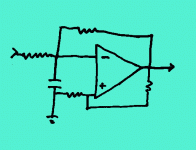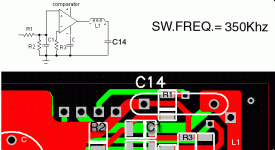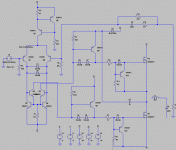Hi,
I'm currently doing some simulation on a Class-d circuit based on Bruno.P's patent. I'm just curious- what is the success rate in designing/bulding a high performance class-d amp. here in this forum? It seems "fairly simple" to design a conventional class-d amp. (triangle-wave-->comparator...) , but these self-oscillating animals might be much harder?
Any hints?
Thanks,
Anders
I'm currently doing some simulation on a Class-d circuit based on Bruno.P's patent. I'm just curious- what is the success rate in designing/bulding a high performance class-d amp. here in this forum? It seems "fairly simple" to design a conventional class-d amp. (triangle-wave-->comparator...) , but these self-oscillating animals might be much harder?
Any hints?
Thanks,
Anders
I don't think self oscillating designs are harder. What's hard
is the same stuff as clocked designs - switching speed,
sensitive comparators, output filtering.
I've built some quite simple Class D amps at relatively low
power levels using plain old IC comparators driving
complementary Mosfets, and decent results were not hard
to achieve. Gordon Holt even said one of them sounded good
(although he is notoriously polite)
is the same stuff as clocked designs - switching speed,
sensitive comparators, output filtering.
I've built some quite simple Class D amps at relatively low
power levels using plain old IC comparators driving
complementary Mosfets, and decent results were not hard
to achieve. Gordon Holt even said one of them sounded good
(although he is notoriously polite)
I have a "working" schematic which have some problem with shoot-through and that measures about 12% THD right now. I have some problem with getting rid of the switching waveform from the audio output. I will post the schematic soon for comments if you're interested.
The reason for my original post is that I don't really understand why no DIY:er has tried the self-oscillating type when it seems to quite doable by reading the Karsten.N thesis and Bruno.P's patent.
Regards,
Anders
The reason for my original post is that I don't really understand why no DIY:er has tried the self-oscillating type when it seems to quite doable by reading the Karsten.N thesis and Bruno.P's patent.
Regards,
Anders
Hi,
One of the DIYaudio (IVX) members has a website with an selfoscillating Class-D amplifiers. I think it is based on the older Philips Soda.
Probably this is a good idee for a DIY project ;-)
http://amploid.narod.ru/article.htm
The sad point it is in Russisch, but with altavista you can translate it.
Succes!
Regards,
Jan-Peter
www.hypex.nl
One of the DIYaudio (IVX) members has a website with an selfoscillating Class-D amplifiers. I think it is based on the older Philips Soda.
Probably this is a good idee for a DIY project ;-)
http://amploid.narod.ru/article.htm
The sad point it is in Russisch, but with altavista you can translate it.
Succes!
Regards,
Jan-Peter
www.hypex.nl
IMHO, layout (and decoupling), that's really important for class D amp generally... My first version of UcD_like amp PCB had some surprise (see attachment), but p2p amp had worked well. BTW, if C14 will be grounded to point between C and R2... will nothing change. Great skill there is, if the first version worked fine.
Commentable Thoughts
The reason is simple , U cant synchronise multiple Self-Oscillating Class-D amps to a common SWitching frequency.
Compliments
AMPMAN
ZeroTHD said:The reason for my original post is that I don't really understand why no DIY:er has tried the self-oscillating type when it seems to quite doable by reading the Karsten.N thesis and Bruno.P's patent.
Regards,
Anders
The reason is simple , U cant synchronise multiple Self-Oscillating Class-D amps to a common SWitching frequency.
Compliments
AMPMAN
Why do you think that ZeroTHD can't do it? Candid camera again is ON?U cant synchronise multiple Self-Oscillating Class-D amps
"Can not" is a strong combination of words...The reason is simple , U cant synchronise multiple Self-Oscillating Class-D amps to a common SWitching frequency.
As I told you before- I'm new to this business, but do I really need to synchronise the switching frequencies? I guess you mean that i.e. the left and the right channel wouldn't oscillate at the same frequency. Do they have to? Can you notice if they differ a few percent?
Regards,
Anders
Can you notice if they differ a few percent?
A few percent could indeed be even worse than a large difference ! This is because they might cause intermodulation products. This all depends on construction, PSU decoupling etc.
Regards
Charles
I guess this would be a problem even in non-self-oscillating designs as long as it runs from separate tri-wave generators. The problem should be solved by minimzing the coupling between the two channels (by distance and by proper PSU design).A few percent could indeed be even worse than a large difference ! This is because they might cause intermodulation products. This all depends on construction, PSU decoupling etc.
Right now I'm having problmens with shoot through. I'm not sure if this is because of imbalance in the circuit, or if I need to incorporate some dead time circuitry.
This is getting interesting!
Thanks,
Anders
Hi Anders,
The routing of the PCB is very importend to avoid coupling of between multichannel Class-D.
Please post your schematic perhaps the forum can give you some idees for decreasing the shoot through problems.
Regards,
Jan-Peter
www.hypex.nl
The routing of the PCB is very importend to avoid coupling of between multichannel Class-D.
Please post your schematic perhaps the forum can give you some idees for decreasing the shoot through problems.
Regards,
Jan-Peter
www.hypex.nl
ZeroTHD
You cannot measure THD in the simulation program without lowpassfiltering extremely hard because of the same reason that you lowpass filter a signal before A/D conversion. My own classD amplifier measures 0,0008% at 1kHz 1W with AP but shows 20% or so in a simulation. Even with third order low pass filter after the second order output filter the simulation shows about 0,5% or so. Don´t really kno why.
In order to reduce shoot through, make sure that the turn off transistor that you use is a high beta type with large bandwidth. If the bandwidth is too low the beta will drop, maybe down to unity, at the switching speeds you are trying to obtain. You will allways have some shoot through though, otherwise the distorsion will increase.
You cannot measure THD in the simulation program without lowpassfiltering extremely hard because of the same reason that you lowpass filter a signal before A/D conversion. My own classD amplifier measures 0,0008% at 1kHz 1W with AP but shows 20% or so in a simulation. Even with third order low pass filter after the second order output filter the simulation shows about 0,5% or so. Don´t really kno why.
In order to reduce shoot through, make sure that the turn off transistor that you use is a high beta type with large bandwidth. If the bandwidth is too low the beta will drop, maybe down to unity, at the switching speeds you are trying to obtain. You will allways have some shoot through though, otherwise the distorsion will increase.
IVX,
No there is no seperate sync input on the UcD180.
I don't have experience with synchronisation but I guess you can try to mix the HF signal together with the input. As far as I understand the UcD will then synchronize to this HF signal.
We use a NE5532 as symmetrical gainstage with a gain of 5x. So the HF signal must pass also the NE5532.
I don't know if this work, anyway I haven't tried it yet.
ZeroTHD,
Did you actually build a physical module for testing?
Regards,
Jan-Peter
www.hypex.nl
No there is no seperate sync input on the UcD180.
I don't have experience with synchronisation but I guess you can try to mix the HF signal together with the input. As far as I understand the UcD will then synchronize to this HF signal.
We use a NE5532 as symmetrical gainstage with a gain of 5x. So the HF signal must pass also the NE5532.
I don't know if this work, anyway I haven't tried it yet.
ZeroTHD,
Did you actually build a physical module for testing?
Regards,
Jan-Peter
www.hypex.nl
- Status
- This old topic is closed. If you want to reopen this topic, contact a moderator using the "Report Post" button.
- Home
- Amplifiers
- Class D
- Success with class-d?




